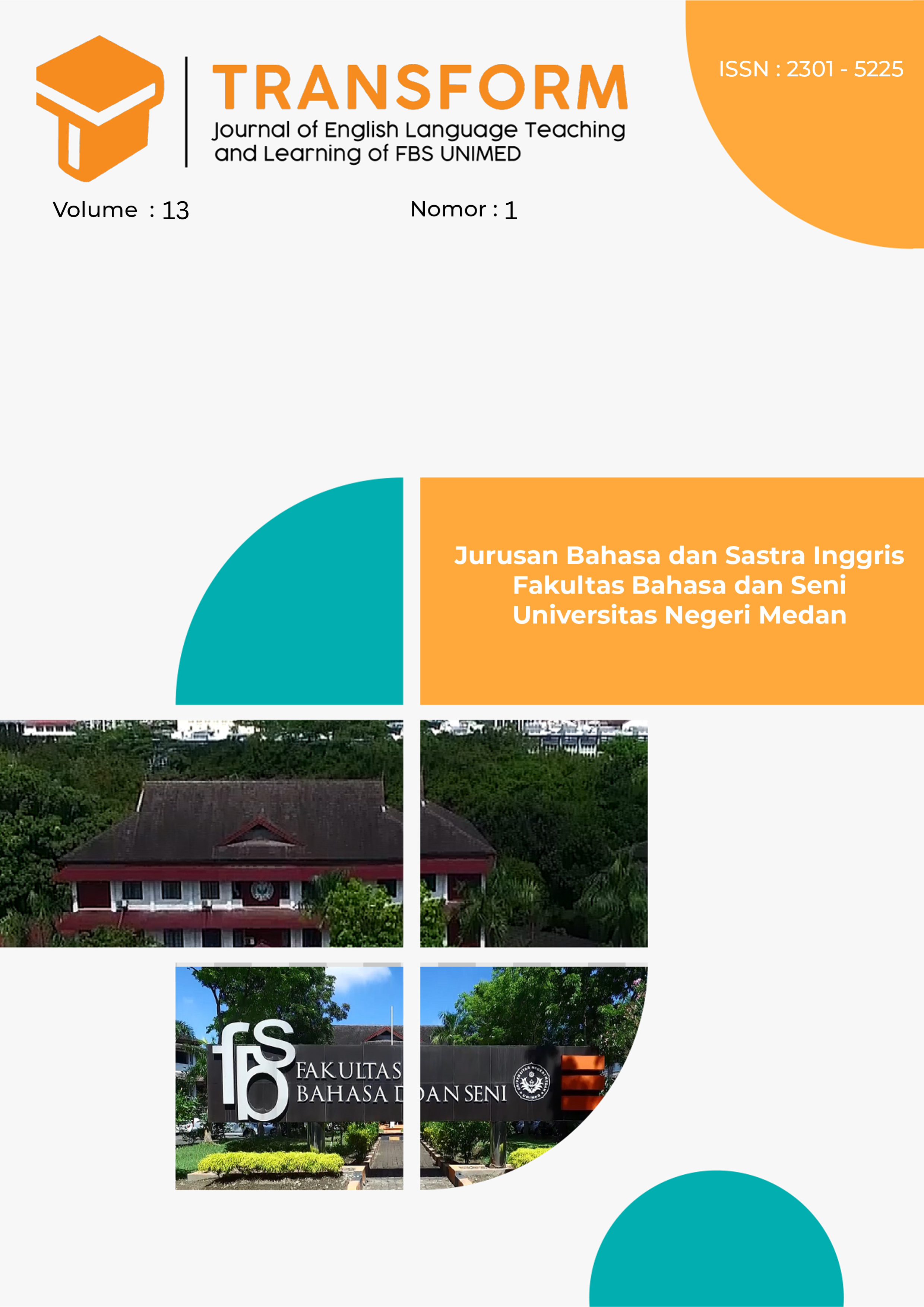Stereotypes in Rebecca Hall™s Movie Passing
DOI:
https://doi.org/10.24114/tj.v13i1.60204Keywords:
Stereotypes, Resistance, Film.Abstract
The objectives of this study were 1) to investigate the pattern of stereotype analysis appeared in Passing movie, 2) to describe characters response the stereotypes that is aimed at them in the movie Passing, 3) to explain the reason characters in Passing movie confront stereotypes instead of conforming. The data in this study are taken from sentences in dialog and scripts contained in the film Passing. 1) There were three types of stereotype patterns according to Brand and Reyna's (2011) theory depicted in the movie Passing. The three types are: Internal/controllable/stable (63.20%) followed by, Internal/uncontrollable/stable (25.50%), and External/uncontrollable/stable (11.3%). 2) The types of resistance reflected in the movie Passing based on King's (2010) theory are Acquiescence (35.71%) followed by Violence (35.71%), and Non-Violence (28.57%). 3) There were three reasons why Black individuals accept stereotypes instead of conforming, based on King's (2010) theory. The first reason is the fear of retaliation, which can lead to conflict. The second reason is a lack of educational awareness, which suggests that white individuals tend to have a broader perspective compared to black people. The third reason is the lack of resources in terms of legal support and financial stability.References
Aginta, Hidayat Medhy., & Suryandari Nikmah. (2022). Undoing Stereotype: Counter-Stereotyping Strategy Based on the Madurese Cultural Identities. 25-42.
Atillah, W., Arifin, M. B., & Valientine, M. N. (2020). An Analysis of Stereotype in Zootopia Movie. Ilmu Budaya, 49-61.
Bordalo, P., Coffman, K., Gennaioli, N., & Shleifer, A. (2015). Stereotypes. 1-3.
Brandt, M., & Reyna, C. (2011). Stereotype as Attributions. Nova Science Publisher, 1-32.
Bielby, W.T. (2000). Minimizing Workplace Gender and Racial Bias. Contemporary Sociology
Blank, R. M. (2004). Measuring Racial discrimination. United States of America: the national academies press.
Cox, W., & Devine, P. (2012). Stereotypes, Prejudice, and Depression The Integrated Perspective. Research Gate, 429.
Creswel, J. W. (1997). Qualitative Inquiry and Research Design. (United States of America: California)
Daalmans, Serena & Odink Mariette. (2019). Stereotype but Liked? A Content Analysis of the Presence and Stereotypical Portrayal of Minority Groups in Award-Winning Commercials. Communication Research Reports, 36:3, 231-241, DOI: 10.1080/08824096.2019.1630605.
Diansari, I. (2014). Analyzing of Racial Discrimination as seen on Freedom writers movie by Richard Lagravenese. English Department-Faculty of Adab and Humanities. Institute For Islamic studies.
Devine, P. G., & Monteith, M. J. (1993). The role of discrepancyassociated affect in prejudice reduction. In D. M. Mackie & D. Hamilton (Eds.), Affect, cognition, and stereotyping: Interactive processes in group perception. San Diego, CA: Academic Press. (pp. 317“344).
Haryati, S. (2013). Pengguna Media Movie Dalam Pengajaran Sastra Berjenis Prosa dan Drama (Analisis Movie The Wolfman Karya Joe Johnston). 450-457.
Hsu, C. H. C., & Chen, N. (2019). Resident Attribution and Tourist Stereotype. Journal of Hospitality & Tourism Research, 1096348018823903. doi: 10.1177/ 1096348018823903
Inayati, R. (2014). Sterotyping Blacks in Richard Wright's Native Son. Prosodi: Jurnal Ilmu Bahasa dan Sastra, 1-9.
Kaiser, C. R., & Miller, C. T. (2001). Reacting to impending discrimination: Compensation for prejudice and attributions to discrimination. Personality Social Psychology Bulletin, 27, 1357- 1367.
Kay, A. C., Gaucher, D., Peach, J. M., Laurin, K., Friesen, J., Zanna, M. P., & Spencer, S. J. (2009). Inequality, discrimination, and the power of the status quo: Direct evidence for a motivation to see the way things are as the way they should be. Journal of personality and social psychology, 97, 421“434.
Kay, M., & Munson, S. A. (2015). Unequal Representation and Gender Stereotype in Image Search Result for Occupations. Research Gate
King, M. L. (2010). Three Ways of Meeting Oppression. Junior AP English Verver. http://mslock.weebly.com/uploads/5/9/3/9/59397655/e2809cthe-ways-of-meeting-oppressione2809d.pdf
Madula, J., Kuncara, S. D., & Asanti, C. (2017). Rebellion Against Racism and Discrimination in The Movies Rise of The Planet of The Apes and Dawn of The Planet of The Apes. Jurnal Ilmu Budaya, (126-139).
McConnell, A. R., & Leibold, J. M. (2001). Relations among the Implicit Association Test, discriminatory behavior, and explicit measures of racial attitudes. Journal of Experimental Social Psychology, 37, 435“442.
Mimi, M. (2019). Content Analysis. Research Gate. 1-14. DOI: 10.13140/RG.2.2.21296.61441
Nurhadi, D. S., & Assidiqi, H. (2019). Racism and Stereotype in Get Out Movie Script. Call, 48-56.
Nurwahyuni, K. & Samelia, M. (2021). Stereotypes and Discrimination in the œGreen Book Movie: A Critical Discourse Analysis. International Journal of Systemic Functional Linguistics. 3(1). 1-7. https://10.22225/ijsfl.v3i1.30 0010.22225/ijsfl.v3i1.3000
Smith, T.W. (2011). Changing Racial Labels From œcolored to œNegro to œBlack to œAfrican American. Oxford: Oxfpord University Press
Downloads
Published
How to Cite
Issue
Section
License
Copyright (c) 2024 Misa Apulina Bnagun, Syamsul Bahri

This work is licensed under a Creative Commons Attribution-ShareAlike 4.0 International License.
Authors who publish with this journal agree with the following terms:
- Authors retain copyright and grant the journal right of first publication with the work simultaneously licensed under a Creative Commons Attribution License that allows others to share the work with an acknowledgment of the work's authorship and initial publication in this journal.
- Authors are able to enter into separate, additional contractual arrangements for the non-exclusive distribution of the journal's published version of the work (e.g., post it to an institutional repository or publish it in a book), with an acknowledgment of its initial publication in this journal.
- Authors are permitted and encouraged to post their work online (e.g., in institutional repositories or on their website) prior to and during the submission process, as it can lead to productive exchanges, as well as earlier and greater citation of published work (See The Effect of Open Access).
- This work is licensed under a Creative Commons Attribution-ShareAlike 4.0 International License.








